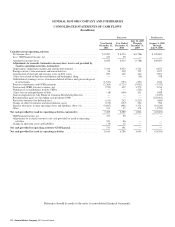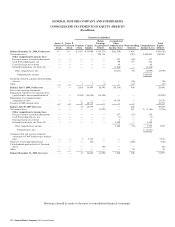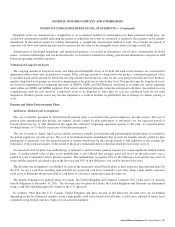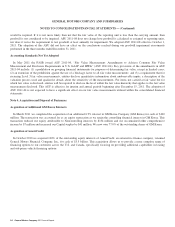General Motors 2011 Annual Report Download - page 87
Download and view the complete annual report
Please find page 87 of the 2011 General Motors annual report below. You can navigate through the pages in the report by either clicking on the pages listed below, or by using the keyword search tool below to find specific information within the annual report.GENERAL MOTORS COMPANY AND SUBSIDIARIES
NOTES TO CONSOLIDATED FINANCIAL STATEMENTS — (Continued)
uses historical charge-off experience to determine a loss confirmation period, which is defined as the time between when an event,
such as delinquency status, giving rise to a probable credit loss occurs with respect to a specific account and when such account is
charged off. This loss confirmation period is applied to the forecasted probable credit losses to determine the amount of losses
inherent in finance receivables at the balance sheet date. Assumptions regarding credit losses and loss confirmation periods are
reviewed periodically and may be impacted by actual performance of finance receivables and changes in any of the factors discussed
above. Should the credit loss assumption or loss confirmation period increase, there would be an increase in the amount of allowance
for loan losses required, which would decrease the net carrying value of finance receivables and increase the amount of provision for
loan losses recorded on the consolidated statements of operations.
Inventory
Inventories are stated at the lower of cost or market. In connection with fresh-start reporting, we elected to use the FIFO costing
method for all inventories previously accounted for by Old GM using the LIFO costing method.
Market, which represents selling price less cost to sell, considers general market and economic conditions, periodic reviews of
current profitability of vehicles, product warranty costs and the effect of current incentive offers at the balance sheet date. Market for
off-lease and other vehicles is current auction sales proceeds less disposal and warranty costs. Productive material, work in process,
supplies and service parts are reviewed to determine if inventory quantities are in excess of forecasted usage, or if they have become
obsolete.
Equipment on Operating Leases, net
Equipment on operating leases, net, including leased vehicles within Total GM Financial Assets, is reported at cost, less
accumulated depreciation, net of origination fees or costs, and lease incentives. Estimated income from operating lease assets, which
includes lease origination fees, net of lease origination costs, is recorded as operating lease revenue on a straight-line basis over the
term of the lease agreement. Depreciation of vehicles is provided on a straight-line basis to an estimated residual value over the term
of the lease agreement.
We have and Old GM had significant investments in vehicles in operating lease portfolios, which are comprised of vehicle leases to
retail customers with lease terms of up to 60 months and vehicles leased to rental car companies with lease terms that average nine
months or less. We are and Old GM was exposed to changes in the residual values of those assets. For impairment purposes, the
residual values represent estimates of the values of the assets at the end of the lease contracts and are determined based on forecasted
auction proceeds when there is a reliable basis to make such a determination. Realization of the residual values is dependent on the
future ability to market the vehicles under the prevailing market conditions. The adequacy of the estimate of the residual value is
evaluated over the life of the lease and adjustments may be made to the extent the expected value of the vehicle at lease termination
changes. Adjustments may be in the form of revisions to the depreciation rate or recognition of an impairment charge. Impairment is
determined to exist if the undiscounted expected future cash flows, which include estimated residual values, are lower than the
carrying amount of the asset. If the carrying amount is considered impaired, an impairment charge is recorded for the amount by
which the carrying amount exceeds the fair value. Fair value is determined primarily using the anticipated cash flows, including
estimated residual values.
In our Automotive operations when a leased vehicle is returned the asset is reclassified from Equipment on operating leases, net to
Inventories at the lower of cost or estimated selling price, less cost to sell. In our Automotive Finance operations when a leased
vehicle is returned or repossessed the asset is recorded in Other assets at the lower of cost or estimated selling price, less costs to sell,
and upon disposition a gain or loss is recorded for any difference between the net book value of the lease and the proceeds from the
disposition of the asset.
Impairment charges related to Equipment on operating leases, net are recorded in Automotive cost of sales or GM Financial
operating and other expenses.
General Motors Company 2011 Annual Report 85
























